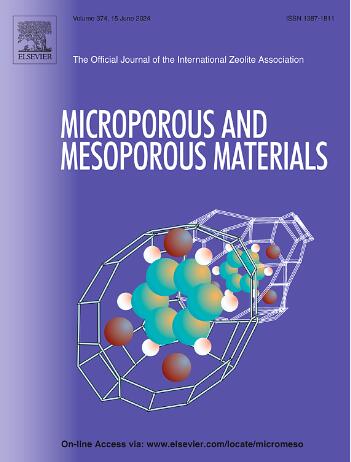Hydration pathways of CaCl2 inside matrices with different pore sizes
IF 4.8
3区 材料科学
Q1 CHEMISTRY, APPLIED
引用次数: 0
Abstract
For use as a heat storage material, CaCl2 is often impregnated into porous materials. This is done to stabilize the salt against conglomeration and its dissolution due to the low deliquescence relative humidity. However, CaCl2 has overlapping temperature and water vapor pressure conditions for its trito- and monohydrate, which are kinetically hindered against each other creating path-dependent (de-)hydration steps. These pathways may change under the influence of confinement. These changes can influence the temperature output for heat batteries using CaCl2 composites and could make the taken pathways for hydration and dehydration either more complex or simpler than the pure salt. So, in this research, the hydration and dehydration steps of CaCl2 inside different clays (Vermiculite, Halloysite, and Sepiolite) and silica gels were investigated with respect to their transformations compared to the bulk salt. Therefore, the kinetic phase transition onsets were determined with isobaric TGA measurements together with PXRD in situ experiments to confirm or identify the crystalline phases. This showed that inside pores, CaCl2 forms the monohydrate rather than the tritohydrate. The decrease of pore diameter leads to easier formation of monohydrate over tritohydrate. This trend can be explained by the crystal structures of the hydrates and their unit cell volumes considering that larger crystals are difficult to form in the limited space inside the pore systems. This change in phase transition steps influences the transition temperatures, which affects its application for heat storage.

不同孔径基质内 CaCl2 的水合路径
本文章由计算机程序翻译,如有差异,请以英文原文为准。
求助全文
约1分钟内获得全文
求助全文
来源期刊

Microporous and Mesoporous Materials
化学-材料科学:综合
CiteScore
10.70
自引率
5.80%
发文量
649
审稿时长
26 days
期刊介绍:
Microporous and Mesoporous Materials covers novel and significant aspects of porous solids classified as either microporous (pore size up to 2 nm) or mesoporous (pore size 2 to 50 nm). The porosity should have a specific impact on the material properties or application. Typical examples are zeolites and zeolite-like materials, pillared materials, clathrasils and clathrates, carbon molecular sieves, ordered mesoporous materials, organic/inorganic porous hybrid materials, or porous metal oxides. Both natural and synthetic porous materials are within the scope of the journal.
Topics which are particularly of interest include:
All aspects of natural microporous and mesoporous solids
The synthesis of crystalline or amorphous porous materials
The physico-chemical characterization of microporous and mesoporous solids, especially spectroscopic and microscopic
The modification of microporous and mesoporous solids, for example by ion exchange or solid-state reactions
All topics related to diffusion of mobile species in the pores of microporous and mesoporous materials
Adsorption (and other separation techniques) using microporous or mesoporous adsorbents
Catalysis by microporous and mesoporous materials
Host/guest interactions
Theoretical chemistry and modelling of host/guest interactions
All topics related to the application of microporous and mesoporous materials in industrial catalysis, separation technology, environmental protection, electrochemistry, membranes, sensors, optical devices, etc.
 求助内容:
求助内容: 应助结果提醒方式:
应助结果提醒方式:


